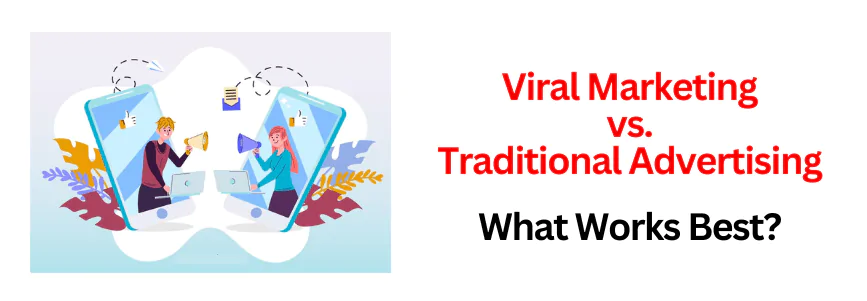Viral Marketing vs. Traditional Advertising: What Works Best?

Marketing is essential to any business, and companies use various methods to promote their products or services. Two popular marketing approaches that often come up in discussions are viral marketing and traditional advertising.
Viral marketing is a relatively new approach that uses social media, email, and other online platforms to spread marketing messages quickly and widely, while traditional advertising includes more traditional channels such as television, radio, billboards, and print media.
Both approaches have their advantages and disadvantages, and businesses must decide which approach is best for them based on factors such as their target audience, budget, and marketing goals. In this blog post, we’ll compare viral marketing and traditional advertising and explore which approach is more effective.
We’ll discuss the differences between the two, their advantages and disadvantages, and provide examples of successful campaigns for both. By the end of this post, you’ll have a better understanding of which marketing approach is right for your business.
Definition:
Viral Marketing:
Viral marketing is a marketing technique that uses social media, email, and other online platforms to spread marketing messages quickly and widely. The goal of viral marketing is to create a buzz around a product, service, or brand, hoping that the message will be shared by consumers with their networks, resulting in exponential growth in visibility and reach.
Traditional Advertising:
Traditional advertising is a form of marketing that uses conventional channels such as television, radio, billboards, and print media to reach an audience. It is typically paid for by the company, and the goal is to target a specific demographic with a message that promotes a product, service, or brand. Unlike viral marketing, which relies heavily on the audience to spread the message, traditional advertising is controlled and distributed by the company or its representatives.
Now let’s take a closer look at both individually before we differentiate them. Firstly, we will talk about Viral Marketing.
Wide Reach:
Viral marketing has the potential to reach a much larger audience than traditional advertising. When a message goes viral, it can be shared and viewed by millions of people across multiple social media platforms.
Cost-effective:
Viral marketing campaigns are often much less expensive than traditional advertising campaigns. Many viral campaigns are created with little or no budget and rely on user-generated content and sharing to spread the message.
Builds Brand Awareness:
Viral marketing campaigns can help build brand awareness and increase brand visibility. When a campaign goes viral, it can generate buzz around a brand and help it stand out in a crowded marketplace.
Increases Engagement:
Viral marketing campaigns can be interactive and engaging, encouraging consumers to participate and share their content. This can help build a community around a brand and create a sense of loyalty among consumers.
Measurable Results:
Viral marketing campaigns can be tracked and measured in real-time, allowing businesses to analyze the success of the campaign and adjust their strategy accordingly. This can help optimize the campaign for maximum impact and ROI.
Overall, viral marketing can be a highly effective way to promote a product or brand, especially for businesses that have a strong online presence and an audience that is active on social media.
Disadvantages of Viral Marketing:
Lack of Control:
One of the biggest disadvantages of viral marketing is that businesses have little control over how their message is shared or interpreted by the audience. Viral campaigns can take on a life of their own and evolve in ways that the business did not intend or anticipate.
Difficult to Predict:
Because viral marketing campaigns rely heavily on the audience to spread the message, it can be difficult to predict whether a campaign will go viral or not. A campaign that is successful for one business may not necessarily work for another, making it a bit of a gamble.
Short-term Impact:
Viral marketing campaigns often have a short lifespan and can quickly become outdated or irrelevant. Once the buzz dies down, it can be challenging to maintain the momentum and sustain interest in the brand or product.
Risk of Negative Feedback:
Viral campaigns can backfire if the message is misinterpreted or if the campaign is seen as offensive or insensitive. This can lead to negative feedback and damage to the brand’s reputation.
Time and Resource Intensive:
Creating a successful viral campaign can be time and resource-intensive, requiring a team of skilled professionals to develop and execute the campaign. For smaller businesses or those with limited resources, this can be a significant barrier to entry.
Overall, while viral marketing can be a highly effective way to promote a product or brand, it is not without its risks and challenges. Businesses should carefully consider the potential disadvantages before deciding to invest in a viral marketing campaign.
Examples of Successful Viral Marketing Campaigns:
Here are a few Examples of Successful Viral Marketing Campaigns:
ALS Ice Bucket Challenge:
The ALS Ice Bucket Challenge was a viral social media campaign that aimed to raise awareness and funds for ALS (amyotrophic lateral sclerosis) research. Participants were challenged to dump a bucket of ice water on their heads and donate to the ALS Association, and then nominate others to do the same. The campaign went viral on social media, with celebrities, politicians, and everyday people participating and sharing their videos. The campaign raised over $220 million worldwide and helped to raise awareness of ALS.
Old Spice’s “The Man Your Man Could Smell Like”:
Old Spice’s “The Man Your Man Could Smell Like” campaign was a viral sensation that used humor and creativity to promote their men’s body wash. In the campaign, a suave and confident spokesperson delivered humorous and unexpected lines. With millions of views on YouTube and social media platforms, the campaign went viral on social media. Old Spice’s sales and brand awareness increased as a result of the campaign.
Coca-Cola “Share a Coke”:
Coca-Cola’s “Share a Coke” campaign was a viral marketing campaign that aimed to increase engagement and brand loyalty among its customers. Customers were encouraged to share a Coke with their family and friends by printing their names on Coca-Cola bottles and cans. Personalized Coke bottles and cans went viral on social media, with customers sharing pictures of them. As a result of the campaign, Coca-Cola’s sales and brand awareness increased.
Blendtec “Will it Blend?”:
Blendtec’s “Will it Blend?” campaign was a viral marketing campaign that showcased the power and durability of their blenders. As part of the campaign, the company’s CEO blended various items, including iPhones, golf balls, and even a garden rake. There were millions of views on YouTube and other social media platforms for the campaign on social media. Blendtec’s sales and brand awareness increased as a result of the campaign.
Overall, these examples demonstrate the power and potential of viral marketing campaigns to increase brand awareness, engagement, and sales.
By now, I think you must have understood what Viral Marketing means, and how much it can help and be a threat. Certainly, case studies would also help you to choose whether you should choose it or not. Now, let’s have a look at Traditional Advertising.
Advantages and Disadvantages of Traditional Advertising:
Advantages:
Targeted Reach:
Businesses can target specific demographics with traditional advertising, such as age, gender, income, and location. This can help ensure that the message reaches the intended audience and increases the chances of a successful campaign.
Tangibility:
Through traditional advertising, consumers can physically interact with the message through print ads, billboards, and radio and TV commercials. This can help create a lasting impression and increase brand recognition.
Established Mediums:
Media such as television, radio, newspapers, and magazines have been used for traditional advertising for decades. These mediums have a large audience base and can help businesses reach a wide range of consumers.
Trusted Source:
In particular, established brands can benefit from traditional advertising because it provides a sense of credibility and trust. Consumers may be more likely to trust a message that comes from a respected and recognizable source.
Measurable Results:
Traditional advertising can be tracked and measured, allowing businesses to analyze the success of the campaign and adjust their strategy accordingly. This can help optimize the campaign for maximum impact and ROI.
Overall, traditional advertising can be a highly effective way to promote a product or brand, especially for businesses that have a specific target audience and want to establish a sense of trust and credibility.
Disadvantages:
High Costs:
The cost of traditional advertising can be high, especially for mediums like television and print. This can be a barrier to entry for smaller businesses or those with limited budgets.
Limited Interaction:
Consumers cannot provide immediate feedback or interact with traditional advertising since it is a one-way communication medium. Because of this, businesses may find it difficult to gauge the success of a campaign or adjust their strategy based on customer feedback.
Declining Effectiveness:
Traditional advertising is facing increasing competition from digital and online advertising, which can be more targeted, cost-effective, and measurable. As a result, traditional advertising’s effectiveness may be declining.
Limited Audience:
Print ads or billboards that are specific to a specific location can limit the reach of traditional advertising. Businesses may have difficulty reaching a wider audience or expanding their customer base due to this.
Short Lifespan:
It is common for traditional advertising campaigns to have a short lifespan and to quickly become outdated or irrelevant. Keeping momentum and sustaining interest in a brand or product can be challenging for businesses.
Overall, while traditional advertising can be an effective way to promote a product or brand, it is not without its risks and challenges. Businesses should carefully consider the potential disadvantages before deciding to invest in a traditional advertising campaign.
Examples of Successful Traditional Advertising Campaigns:
Here are some examples of successful traditional advertising campaigns:
Nike “Just Do It”:
Nike’s “Just Do It” campaign is a classic example of successful traditional advertising. First launched in 1988, the campaign featured TV commercials and print ads highlighting the importance of hard work, determination, and athletic performance. Nike was able to establish itself as a leading sports brand and increase sales as a result of the campaign.
Volkswagen “Think Small”:
Volkswagen’s “Think Small” campaign is another classic example of successful traditional advertising. Initially launched in 1959, this campaign featured print ads with an emphasis on the affordability and practicality of the Volkswagen Beetle. By establishing the Beetle as an iconic car, the campaign increased sales.
Coca-Cola “Hilltop”:
Coca-Cola’s “Hilltop” campaign is a timeless example of successful traditional advertising. An early TV commercial for the campaign featured a group of people singing “I’d Like to Buy the World a Coke” on a hilltop. Coca-Cola’s global branding campaign helped increase sales and establish the brand as a global leader.
Apple “Think Different”:
Apple’s “Think Different” campaign is a modern example of successful traditional advertising. A series of TV commercials and print ads promoting the company’s innovation and creativity was part of the campaign, which was launched in 1997. Apple was able to establish itself as a leading technology brand and increase sales as a result of the campaign.
Overall, these examples demonstrate the power and potential of traditional advertising campaigns to increase brand awareness, engagement, and sales.
Which is more effective?
At last, after understanding both in detail, here comes the main question: Which is more effective and which to choose? Well, Determining whether viral marketing or traditional advertising is more effective can depend on various factors, such as the product or service being promoted, the target audience, the marketing budget, and the goals of the campaign.
Viral marketing can be highly effective in generating buzz and increasing brand awareness quickly and at a relatively low cost. It can also create a sense of engagement and participation among consumers, which can lead to increased loyalty and customer retention.
On the other hand, traditional advertising can provide a more targeted reach and established mediums to reach a wide range of consumers. It can also provide a sense of credibility and trust, which can be especially important for established brands or products.
Ultimately, the most effective approach may involve a combination of both viral marketing and traditional advertising, depending on the specific needs and goals of the campaign. For example, a viral marketing campaign may be effective in generating initial buzz and interest, while traditional advertising can help to establish credibility and increase sales over time.
Conclusion
In conclusion, the debate between viral marketing and traditional advertising is an ongoing one. While both approaches have their advantages and disadvantages, the effectiveness of each can depend on various factors. Viral marketing can be a powerful tool for generating buzz and increasing brand awareness quickly and cost-effectively, while traditional advertising can provide a more established and targeted reach.
Ultimately, the choice between viral marketing and traditional advertising should be based on the specific needs and goals of the campaign, as well as the target audience and available resources. By carefully considering these factors and crafting a well-designed marketing strategy, businesses can effectively promote their products or services and achieve their marketing objectives



